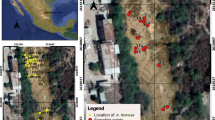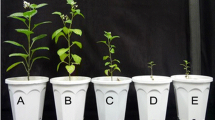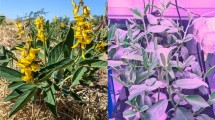Abstract
Aims
A complete study of the distribution and localization of metals, especially iron, in the Fe hypertolerant, Imperata cylindrica, in its natural habitat from Rio Tinto riverbeds and in controlled laboratory conditions has been carried out.
Methods
Different analytical (ICP-MS (inductive coupled plasma mass spectrometry) and microscopic techniques such as OM (optical microscopy) with histochemical staining (Prussian Blue stain formation for iron staining), SEM and TEM (scanning and transmission electronic microscopy) coupled with EDX (energy dispersive X-ray) have been used to analyze the plant organs and tissues.
Results
The Fe accumulation and biomineralization capacities of I. cylindrica are corroborated in both wild and controlled laboratory conditions. Fe accumulation was found in the cell walls and intercellular spaces of most of the tissues, excluding sclerenchyma cells, of every plant vegetative organ and endodermis of root cells. Jarosite and Fe-oxides were observed in both wild and treated samples. Moreover greenhouse treated plants have the same Fe distribution pattern as wild plants, though differences in their nutrient and metal concentrations are observed.
Conclusions
The Prussian blue staining combined with the microscopic techniques here used is an effective method for the analysis of Fe in hypertolerant plants.


Similar content being viewed by others
References
Amils R, de la Fuente V, Rodríguez N, Zuluaga J, Menéndez N, Tornero J (2007) Composition, speciation and distribution of iron minerals in Imperata cylindrica. Plant Physiol Bioch 45:335–340
Barton L (2012) Iron chelation in plants and soil microorganisms. Academic Press, Cambridge
Brooks RR (1998) Plants that hyperaccumulate heavy metals: their role in phytoremediation, microbiology, archaeology, mineral exploration and phytomining. CAB International, NewYork
Crowder A, St-Cyr L (1991) Iron oxide plaques on wetland roots. Trends Soil Sci 1:315–329
Franco A, Rufo L, Rodríguez N, Amils R, de la Fuente V (2013a) Iron absorption, localization, and biomineralization of Cynodon dactylon, a perennial grass from the Río Tinto basin (SW Iberian peninsula). J Plant Nutr Soil Sc 176:836–842
Franco A, Rufo L, Zuluaga J, de la Fuente V (2013b) Metal uptake and distribution in cultured seedlings of Nerium oleander L. (Apocynaceae) from the Río Tinto (Huelva, Spain). Biol Trace Elem Res 155:82–92
Franco A, Rufo L, de la Fuente V (2015) Fe absorption and distribution of Imperata cylindrica (L.) P. Beauv. Under controlled conditions. J Environ Anal Toxicol 5(6):1–7. doi:10.4172/2161-0525.1000335
Fuente V, Rufo L, Rodríguez N, Amils R, Zuluaga J (2010) Metal accumulation screening of the Río Tinto flora (Huelva, Spain). Biol Trace Elem Res 134:318–341
Fuente V, Rodríguez N, Amils R (2012) Immunocytochemical analysis of the subcellular distribution of ferritin in Imperata cylindrica (L.) Raeuschel, an iron hyperaccumulator plant. Acta Histochem 114:232–236
Fuente V, Rufo L, Juárez BH, Menéndez N, García-Hernández M, Salas-Colera E, Espinosa A (2016) Formation of biomineral iron oxides compounds in a Fe hyperaccumulator plant: Imperata cylindrica (L.) P. Beauv. J Struc Biol 193:23–32
Gajdardziska-Josifovska M, McClean RG, Schofield MA, Sommer CV (2001) Discovery of nanocrystalline botanical magnetite. Eur J Mineral 13:863–870
Goodman B, DeKock P (1982) Mössbauer studies of plant materials. I. Duckweed, stocks, soybean and pea. J Plant Nutr 5:345–353
Goodman B, DeKock P, Rush J (1982) Mössbauer studies of elant materials. II. Spectra of 57fe-enriched duckweed at low temperatures. J Plant Nutr 5:355–362
Jiménez S, Morales F, Abadía A, Abadía J, Moreno M, Gogorcena Y (2009) Elemental 2-D mapping and changes in leaf iron and chlorophyll in response to iron re-supply in iron-deficient GF 677 peach-almond hybrid. Plant Soil 315:93–106
Kamnev AA, KovacS K, Alenkina IV, Oshtrakh MI (2013) Mössbauer spectroscopy in biological and biomedical research. Mössbauer Spectroscopy: Applications in Chemistry, Biology, Industry, and Nanotechnology, pp 272–291
Kilcoyne S, Bentley P, Thongbai P, Gordon D, Goodman B (2000) The application of 57 Fe Mössbauer spectroscopy in the investigation of iron uptake and translocation in plants. Nucl Instrum Methods Phys Res, Sect B 160:157–166
Kovács K, Kuzmann E, Fodor F, Cseh E, Homonnay Z, Vértes A (2009) Mössbauer investigation of iron uptake in wheat. ICAME 2007 Springer, pp 743–747
McClean RG, Schofield MA, Sommer CV, Robertson DP, Dick T, Gajdardziska-Josifovska M (2001) Botanical iron minerals correlation between nanocrystal structure and modes of biological self-assembly. Eur J Mineral 13:1235–1242
Pardha-Saradhi P, Yamal G, Peddisetty T, Sharmila P, Singh J, Nagarajan R, Rao K (2014) Plants fabricate Fe-nanocomplexes at root surface to counter and phytostabilize excess ionic Fe. Biometals 2:97–114
Piquer C, Laguna-Marco M, Roca A, Boada R, Guglieri C, Chaboy J (2014) Fe KEdgeX-ray absorption spectroscopy study of nanosized nominal magnetite. J Phys Chem C 118:1332–1346
Rodríguez N, Menéndez N, Tornero J, Amils R, de la Fuente V (2005) Internal iron biomineralization in Imperata cylindrica, a perennial grass: chemical composition, speciation and plant localization. New Phytol 165:781–789
Roschzttardtz H, Conéjéro G, Curie C, Mari S (2009) Identification of the endodermal vacuole as the iron storage compartment in the Arabidopsis embryo. Plant Physiol 151:1329–1338. doi:10.1104/pp.109.144444
Rufo L, Rodríguez N, Amils N, de la Fuente V, Jiménez-Ballesta R (2007) Surface geochemistry of soils associated to the Tinto River (Huelva, Spain). Sci Total Environ 378:223–227
Rufo L, Rodríguez N, de la Fuente V (2010) Chemical and mineralogical characterization of the soils of the main plant communities of the 'Río Tinto' basin. Schironia 9:5–12
Rufo L, Franco A, de la Fuente V (2014) Silicon in Imperata cylindrica (L.) P. Beauv: content, distribution, and ultrastructure. Protoplasma 251:921–930
Størmer FC, Wielgolaski FE (2010) Are magnetite and ferritin involved in plant memory? Rev Environ Sci Biotechnol 9:105–107
Taylor GJ, Crowder AA, Rodden R (1984) Formation and morphology of an iron plaque on the roots of Thypha latifolia L. grown in solution culture. Am J Bot 71:666–675
Theil EC (1987) Ferritin: structure, gene regulation, and cellular function in animals, plants, and microorganisms. Annu Rev Biochem Biophys Acta 1275:161–203
Wade VJ, Treffry A, Laulhère JP, Bauminger ER, Cleton MI, Mann S, Briat JF, Harrison PM (1993) Structure and composition of ferritin cores from pea seed (Pisum sativum). BBA-Protein Struc M 1161:91–96
Zuluaga J, Rodríguez N, Rivas-Ramirez I, Fuente V, Rufo L, Amils R (2011) An improved semi-quantitative method for elemental analysis of plants using inductive coupled plasma-mass spectrometry. Biol Trace Elem Res 144:1302–1317
Acknowledgments
Grants CGL2006-02534/BOS, CGL2012-34020 and CGL2015-66242-R from the Spanish Ministerio de Educación y Ciencia and the Ministerio de Economía y Competitividad are acknowledged.
Author information
Authors and Affiliations
Corresponding author
Additional information
Responsible Editor: Lourdes Hernández-Apaolaza.
Rights and permissions
About this article
Cite this article
de la Fuente, V., Rufo, L., Rodríguez, N. et al. Comparison of iron localization in wild plants and hydroponic cultures of Imperata cylindrica (L.) P. Beauv.. Plant Soil 418, 25–35 (2017). https://doi.org/10.1007/s11104-017-3251-8
Received:
Accepted:
Published:
Issue Date:
DOI: https://doi.org/10.1007/s11104-017-3251-8




